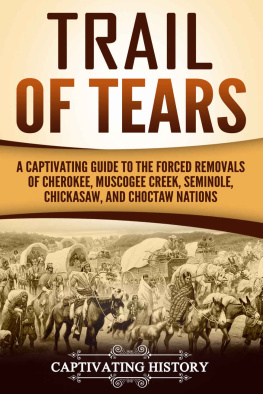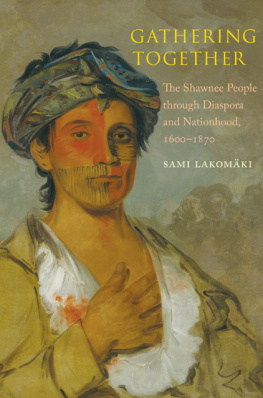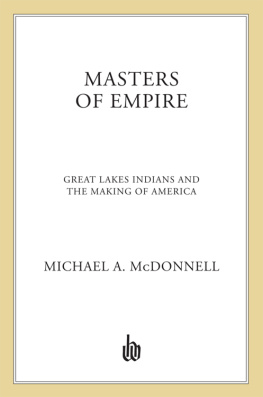Peoples of the Inland Sea
NEW APPROACHES TO MIDWESTERN STUDIES
Series editors: Paul Finkelman and L. Diane Barnes
Nikki M. Taylor, Driven toward Madness: The Fugitive Slave Margaret Garner and Tragedy on the Ohio
Jenny Bourne, In Essentials, Unity: An Economic History of the Grange Movement
David Andrew Nichols, Peoples of the Inland Sea: Native Americans and Newcomers in the Great Lakes Region, 16001870
Peoples of the Inland Sea
Native Americans and Newcomers in the Great Lakes Region, 16001870
DAVID ANDREW NICHOLS
OHIO UNIVERSITY PRESS
ATHENS
Ohio University Press, Athens, Ohio 45701
ohioswallow.com
2018 by Ohio University Press
All rights reserved
To obtain permission to quote, reprint, or otherwise reproduce or distribute material from Ohio University Press publications, please contact our rights and permissions department at (740) 593-1154 or (740) 593-4536 (fax).
Printed in the United States of America
Ohio University Press books are printed on acid-free paper 
28 27 26 25 24 23 22 21 20 19 18 5 4 3 2 1
Library of Congress Cataloging-in-Publication Data
Names: Nichols, David Andrew, 1970- author.
Title: Peoples of the Inland Sea : Native Americans and Newcomers in the Great Lakes Region, 1600-1870 / David Andrew Nichols.
Description: Athens, Ohio : Ohio University Press, 2018. | Series: New Approaches to Midwestern History | Includes bibliographical references and index.
Identifiers: LCCN 2018000074| ISBN 9780821423196 (hardback) | ISBN 9780821423202 (pb) | ISBN 9780821446331 (pdf)
Subjects: LCSH: Indians of North America--Great Lakes Region (North America)--History. | Great Lakes Region (North America)--History. | BISAC: HISTORY / United States / General. | HISTORY / Native American.
Classification: LCC E78.G7 N53 2018 | DDC 977--dc23
LC record available at https://lccn.loc.gov/2018000074
For Patrick
Frater et philosophus
Contents
Illustrations
FIGURES
MAPS
Series Editors Preface
For much of American history the term Midwest evoked images of endless fields of grain, flat, treeless landscapes, and homogenized populations in small towns. Most Americans hear Midwest and think of corn, wheat, soybeans, massive feedlots, huge pig farms, and countless dairy herds. The cinematic Midwest was River City, Iowa, in The Music Man; Dorothy trying to escape Oz and get back to Kansas; the iconic power of small-town basketball portrayed in Hoosiers; or a mythical baseball diamond in rural Iowa in Field of Dreams. In the late twentieth century, images of deindustrialization and decay linked the region to a new identity as the nations Rust Belt. For too many Americans, the Midwest has been flyover country.
This book series explores regional identity in the nations past through the lens of the American Midwest. Stereotypical images of the region ignore the complexity and vibrancy of the region, as well as the vital role it has playedand continues to playin the nations economy, politics, and social history. In the antebellum and Civil War periods the Midwest was home to virulent racist opponents of black rights and black migration but also to a vibrant antislavery movement, the vigorous and often successful Underground Railroad, and the political and military leadership that brought an end to slavery and reframed the Constitution to provide at least formal racial equality. A midwestern president issued the Emancipation Proclamation, and midwestern generals led the armies that defeated the southern slaveocracy. Midwestern politicians authored the Thirteenth Amendment ending slavery and the Fourteenth Amendment mandating legal equality for all Americans. The political impact of the region is exemplified by the fact that from 1860 to 1932 only two elected presidents (Grover Cleveland and Woodrow Wilson) were not from the Midwest. Significantly, from 1864 until the 1930s every Chief Justice but one was also a midwesterner.
While many Americans imagine the region as one of small towns and farms, the Midwest was the home to major urban centers. In 1920 three of the five largest cities in the nation were in the Midwest, and even today, despite massive migration to the sunbelt, there are four midwestern cities in the top fifteen. The great urban centers of the Midwest include Chicago, Detroit, Cincinnati, Cleveland, Columbus, Indianapolis, Milwaukee, Minneapolis, St. Louis, and Kansas City. For a centuryfrom the late nineteenth century to the late twentieth centurythe region was not only an agricultural heartland but also the nations industrial heartland. Many of the key industries of the twentieth century began in the Midwest and developed there. Many midwestern cities were known by the industries they dominated, such as Detroit (automobiles), Toledo (glass), Akron (rubber), flour and milling (Minneapolis), and even breakfast cereals (Battle Creek). While most Americans associate the oil industry with Texas and Oklahoma, it began with John D. Rockefellers Standard Oil Company in Cleveland. The airplane industry began with the Wright Brothers in Ohio and with the manufacturing of planes in Wichita. While Pittsburgh (which was almost a mid-western city) called itself the steel city, more steel was manufactured in Youngstown, Gary, Chicago, Cleveland, and other midwestern cities, usually from ore that came from Minnesotas Iron Range. The Midwest was always Americas agricultural heartland, producing grains, pork, beef, and dairy products. But this food production led to midwestern industries beyond the farms. Beef and pork raised in the Midwest were processed and packaged in Cincinnati in the antebellum period, and later in Chicago and other cities. Midwestern farmers and food processors fed the nation at lunch and dinner, while General Mills, Kellogg, and Quaker Oats, complemented by bacon from Swift, Armor, and Hormel, provided breakfast for the nation. The cows and hogs that fed the nation were themselves fed by midwestern feed companies, while the crops were cultivated and harvested using machines built by International Harvester, John Deere, Massey-Ferguson, and similar companies.
All of these products were grown, processed, and manufactured by migrants from the East and the South, and immigrants mostly from Central, Eastern, and Southern Europe and the Ottoman Empire. The Midwest of the popular imagination was homogeneous and almost boring; in reality the Midwest that emerged in the early twentieth century was as culturally, ethnically, racially, and religiously diverse as it was economically diverse.
The books in this series capture the complexity of the Midwest and its historical and continuing role in the development of modern America.
David Nicholss Peoples of the Inland Sea provides a solidly researched exploration of American Indians in the region that we now call the Midwest. Its unique analysis begins in the seventeenth century, when Europeans and Native Americans first came into contact in the region, and traces events and important individuals through the late early republic, which by 1830 witnessed the almost total loss of Indian lands to American settlement. The removal of some 50,000 Indians from the Great Lakes region did not erase their history or their significant accomplishments, triumphs, and tragedies. Nichols captures those experiences, giving voice to the 170,000 Lakes Indians who lived near the Great Lakes basin by 1600. A diverse people, Lakes Indians represented more than a dozen different nations, lived in settled towns and villages, and traded over long distances. Their strong numbers began to recede as soon as Europeans found value in the trade and landholding opportunities surrounding the Great Lakes. Lakes Indian domination proved to be no match for the thousands of French and then British who flooded into the Great Lakes region. In the late seventeenth century their alliance with the French set the Lakes Indians on a path of cooperation and conflict that ended in the British triumph in the French and Indian War (Seven Years War). Relations with the British soon soured and the stand Lakes Indians waged in Pontiacs War foretold generations of conflict between Europeans and Native Americans in the Midwest. Nichols masterfully captures this narrative, detailing the history of individual tribes and their interactions with other Lakes Indians and the Europeans. His study fills an important gap in the early history of the American Midwest.
Next page





